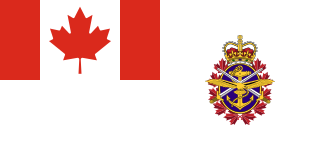
The Army of the Republic of North Macedonia is the armed force of North Macedonia. The army is organized, prepared and trained to conduct armed struggle and combat and other actions to achieve its constitutional function of defending the independence and territorial integrity of North Macedonia. The army consists of the ground forces and the air force, which are further divided into branches and services. The army has a permanent composition and reserve forces. Since 2005, it is a fully professional defense force compatible with NATO standards.

The Canadian Armed Forces are the unified military forces of Canada, including sea, land, and air elements referred to as the Canadian Army, Royal Canadian Navy, Royal Canadian Air Force, and Canadian Special Operations Forces Command.

The Joint Chiefs of Staff (JCS) is the body of the most senior uniformed leaders within the United States Department of Defense, which advises the president of the United States, the secretary of defense, the Homeland Security Council and the National Security Council on military matters. The composition of the Joint Chiefs of Staff is defined by statute and consists of a chairman (CJCS), a vice chairman (VJCS), the chiefs of the Army, Marine Corps, Navy, Air Force, Space Force, and the chief of the National Guard Bureau. Each of the individual service chiefs, outside their JCS obligations, works directly under the secretaries of their respective military departments, e.g. the secretary of the Army, the secretary of the Navy, and the secretary of the Air Force.
Defence Research and Development Canada is the science and technology organization of the Department of National Defence (DND), whose purpose is to provide the Canadian Armed Forces (CAF), other government departments, and public safety and national security communities with knowledge and technology.

The Permanent Joint Headquarters (PJHQ) is the British tri-service headquarters from where all overseas military operations are planned and controlled. It is situated at Northwood Headquarters in Northwood, London. The Permanent Joint Headquarters is commanded by the Chief of Joint Operations (CJO), the position of which is currently held by Lieutenant General Charles Stickland.

The United Kingdom's Strategic Command (StratCom), previously known as Joint Forces Command (JFC), manages allocated joint capabilities from the three armed services.

Personnel branches, in the Canadian Armed Forces (CAF), are groupings of related military occupations.

The National Command Authority (NCA) is an independent federal agency of the Government of Pakistan that is responsible for safeguarding of the national security through the military applications of the nuclear science.

Canadian Special Operations Forces Command is a command of the Canadian Armed Forces. It is responsible for all special forces operations that respond to terrorism and threats to Canadians and Canadian interests around the world.

The Ministry of Defence of Ukraine is the ministry of the Ukrainian government that oversees national defence and the Armed Forces of Ukraine. The head of the ministry is the Minister of Defence. The President of Ukraine is the Supreme Commander-in-Chief of the Armed Forces of Ukraine.
The Australian Defence Organisation (ADO) is composed of the armed forces of the Commonwealth of Australia, the Australian Defence Force (ADF), and the Australian Public Service government department, the Department of Defence which is composed of a range of civilian support organisations.

The Estonian Defence Forces is the unified military force of the Republic of Estonia. The Estonian Defence Forces consists of the Estonian Land Forces, the Estonian Navy, the Estonian Air Force, and the paramilitary Estonian Defence League. The national defence policy aims to guarantee the preservation of the independence and sovereignty of the state, the integrity of its land area, territorial waters, airspace and its constitutional order. Its main goals remain the development and maintenance of a credible capability to defend the nation's vital interests and development of the defence forces in a way that ensures their interoperability with the armed forces of NATO and European Union member states to participate in the full range of missions for these military alliances.

The Ministry of Defence is a Ministry of the Federal Government of Nigeria with the statutory responsibility of overseeing and supervising the Nigerian Armed Forces. The Ministry of Defence is headed by the Minister of Defence, a cabinet-level head who reports directly to the President of the Federal Republic of Nigeria. Its main mission is to provide administrative and support services, timely and effectively to enable the Armed Forces of the Federal Republic of Nigeria.
The Confédération Interalliée des Officiers de Réserve (CIOR) or Interallied Confederation of Reserve Officers is an association of reserve officers' associations in NATO and beyond. CIOR is sanctioned and formally recognized by NATO through the document MC 0248/2 to assist and advise on reserve affairs, however, it is politically independent. The confederation promotes and organizes advanced training measures, international seminars and working meetings for reserve officers.

National Defence Headquarters (NDHQ) was created through the integration of the Canadian Armed Forces Headquarters with the civilian Department of National Defence (DND) staff in October of 1972. NDHQ is not a specific location, but is instead housed throughout a collection of offices in buildings across the National Capital Region, although it is most commonly identified with the Major-General George R Pearkes Building on Colonel By Drive in Ottawa.
The Department of National Defence is the department of the Government of Canada which supports the Canadian Armed Forces in its role of defending Canadian national interests domestically and internationally. The department is a civilian organization, part of the public service, and supports the armed forces; however, as a civilian organization is separate and not part of the military itself. National Defence is the largest department of the Government of Canada in terms of budget, and it is the department with the largest number of buildings.
The House of Commons Standing Committee on National Defence (NDDN) is a standing committee of the House of Commons of Canada. Prior to 2007, it was the House of Commons Standing Committee on National Defence and Veterans' Affairs.
The Defence Public Affairs Learning Centre (DPALC) is a Canadian military training institution that provides Department of National Defence and Canadian Armed Forces personnel with specialized military public affairs and communications training. It is part of the Assistant Deputy Minister organization and executes its mandate under the authority of the Canadian Defence Academy.
The Defence Staff is the Supreme Commander of the Swedish Armed Forces' staff body and command resource for military strategic command, mission dialogue and reporting to the Swedish government, as well as being responsible for the war organization's capability, availability and combat readiness. The latter with the support of the service branch commanders and the service branch staffs.

Federated Mission Networking (FMN) is a significant initiative to help ensure interoperability and operational effectiveness of the North Atlantic Treaty Organization, it is a key contribution to the Connected Forces Initiative, helping Allied and Partner forces to better communicate, train and operate together. This includes the NATO Command Structure as well as the NATO Force Structure. The purpose of FMN is ultimately to support Command, Control, Communications, Computers, Intelligence, Surveillance and Reconnaissance (C4ISR) and decision-making in operations by enabling a rapid instantiation of mission networks. Including the NATO Command Structure, 37 nations have joined the FMN initiative as so called "FMN Affiliates" and work together under the FMN Framework Process to coordinate the design, development and delivery of operational and technical capabilities required to conduct net-centric operations. Each development increment is referred to as an "FMN Spiral". The respective requirements, architecture, standards, procedural and technical instructions are documented in so called "FMN Spiral Specifications". FMN Spiral Specifications are based on well known standards and best practices, hence supported by most off-the-shelf products and vendor neutral. TACOMS standards and profiles specify a common, technology and topology independent network interoperability layer for federated mission networks. There is also a rolling 10-year FMN Spiral Specification Roadmap of the envisioned future capabilities. At the same time, the Coalition Interoperability Assurance and Validation (CIAV) process ensures that current interoperability issues are being identified and fed back into FMN capability development.













